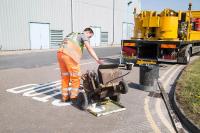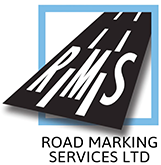 Add My Company
Add My Company
Sign In
HOW DO THEY MAKE THE LINES ON THE ROAD?
06-11-2021

Are you wondering “how do they make the lines on the road?” If so, you’re not alone. This is a common question, with many people intrigued as to how these perfect white markings get onto our nation’s highways. At Road Marking Services, we’re a leading white lining contractor and we know all there is to know about applying white lines to roads.
WHAT ARE THE WHITE LINES ON ROADS?
How do they make the lines on the road?
How do they make the lines on the road?
Before we answer the question “how do they make the lines on the road”, let’s take a closer look at what they are and why they are so essential. The white lines you see on the roads communicate key information to motorists and pedestrians. They are vital for road safety since they make road users aware of upcoming hazards and deliver key information to help us drive appropriately for the situation. Without clear and visible markings, confusion can occur on the roads, leading to accidents for both motorists and pedestrians.
WHAT MATERIALS ARE USED FOR ROAD MARKINGS?
In many cases, thermoplastic is the preferred choice for road markings. Quick-drying, hardwearing, and reflective, this material is ideal for high-traffic roads and highways. If thermoplastic isn’t suitable, other materials such as epoxy, chlorinated rubber paint or water-based paints are alternative options. At Road Marking Services, we generally use thermoplastic for roading markings due to its properties. One of the biggest benefits of thermoplastic markings is that they can become highly reflective. This makes them easier to see at night or in poor weather conditions where visibility is bad. We’ll always ensure we use the right material to meet your specific needs.
HOW ARE THERMOPLASTIC ROAD MARKINGS MADE?
Thermoplastic road markings combine synthetic resin and premix glass beads. Since thermoplastic paint starts as a solid powder, it requires specialised machines to heat it. Once the paint melts, it goes into the road marking machine and then onto the roads.
The hot thermoplastic paint cools into a line and takes around two hours to fully dry, attaching strongly to the surface. Thermoplastic is ideal for all forms of marking, from marking out traffic lanes and bus stops to displaying directions in car parks. Although thermoplastic road markings are usually white, they can become coloured by adding various pigments. Extra additives can help the roading markings retain their colour and improve their reflective capabilities over time.
EPOXY ROAD MARKINGS
Epoxy resin is a common option for road markings. Consisting of a pigmented resin base and a hardener, it’s a very durable solution. Before it’s applied, both components are mixed together, with two parts resin and one part hardener. Since the mix proportions are vital for the quality of the material, it’s important to ensure they are correct before applying. The epoxy resin is sprayed onto the road surface and is sometimes combined with reflective glass beads to deliver night-time retro-reflectivity. Epoxy is generally applied at lower temperatures and creates a strong mechanical bond with the road surface.
CHLORINATED RUBBER PAINT MARKINGS
Road Marking Company Sheffield
Chlorinated rubber paint is another option for road marking. A strong and robust thermoplastic resin, this material is soluble yet incombustible. The chlorine content within it makes it both versatile and incredibly hardwearing. It’s ideal for busy environments where surfaces are subject to lots of wear and tear. Chlorinated rubber paint is ideal for a range of surfaces, including tarmac, concrete, and paving. Since it’s so fast-drying, roads and car parks can be back in service very quickly.
WATER-BASED PAINT MARKINGS
Water-based paint is sometimes used for road marking in Sheffield and Leeds. Low-profile and anti-slip, it’s ideal for settings such as airfield runways or race tracks. These surfaces should be free from foreign object debris. Water-based paint is available in a variety of colours, making it a suitable choice for car parks, shipping ports, warehouses, and transport yards too. It is more environmentally friendly than other options.
HOW ARE ROAD MARKINGS APPLIED SO ACCURATELY?
Many people wonder how we paint road markings so accurately. On major roads, dedicated road-marking vehicles apply the paint extremely precisely using a computer. A highly skilled steersman operates the vehicle, making sure the lines are applied correctly and at the right pace. On smaller roads, the paint is usually applied using a laying pram – a metal trolley that is equipped with a heater to ensure the paint remains nice and fluid. The steersman must follow the surveyed lines at the right rate to ensure that the lines are the proper length and thickness. They must also stop and start the flow of paint correctly in order to achieve the right pattern.
GET EXPERT ADVICE FROM ROAD MARKING SERVICES
At Road Marking Services, we’ve been providing road marking services in Sheffield and Leeds for many years. We are the leading white lining contractors and we have a fantastic reputation across the region. So, it makes sense to contact us if you’re seeking expert advice on road markings. Whether you’re still wondering “how do they make lines on the road?” or you have other questions you need answers to, we can assist. There’s no job too big or too small for our team to handle, so you can be sure that we can provide a service that meets your needs. We provide professional road marking services at highly competitive prices.
CONTACT US
Road Marking Services specialise in road marking in Sheffield, Leeds and the surrounding areas. Call us on 0800 086 2509 to talk to one of our experienced team. We’re available seven days a week to discuss your requirements. You can also send us a message via our website with any questions or queries. We strive to ensure our customers always receive a first-class service, with all work fully guaranteed.
For more information on HOW DO THEY MAKE THE LINES ON THE ROAD? talk to Road Marking Services
Enquire Now
List your company on FindTheNeedle.

